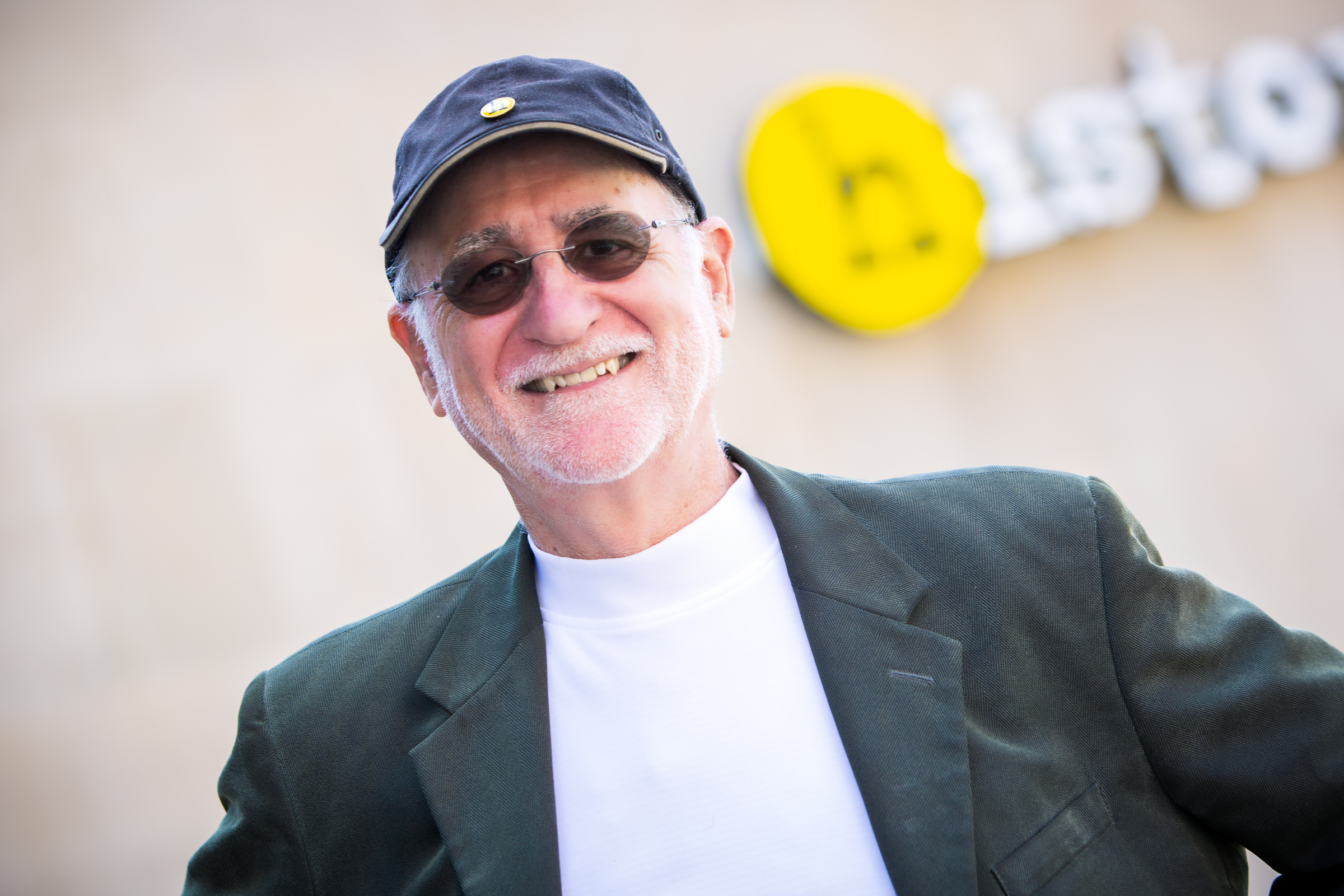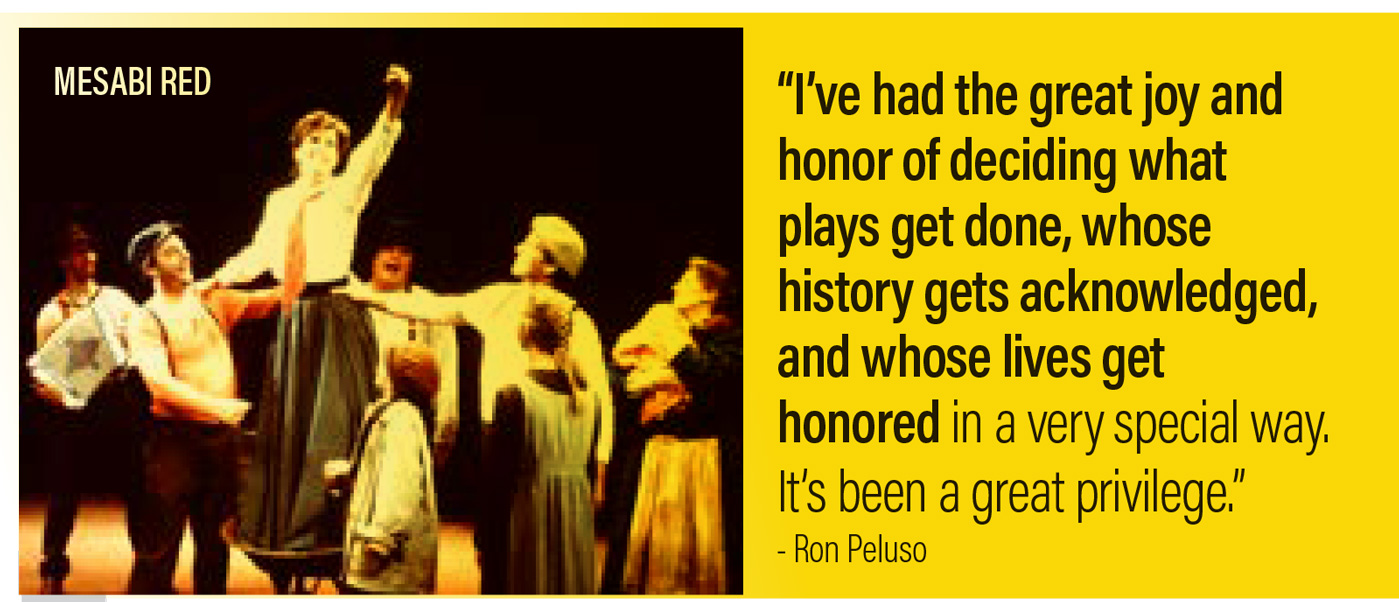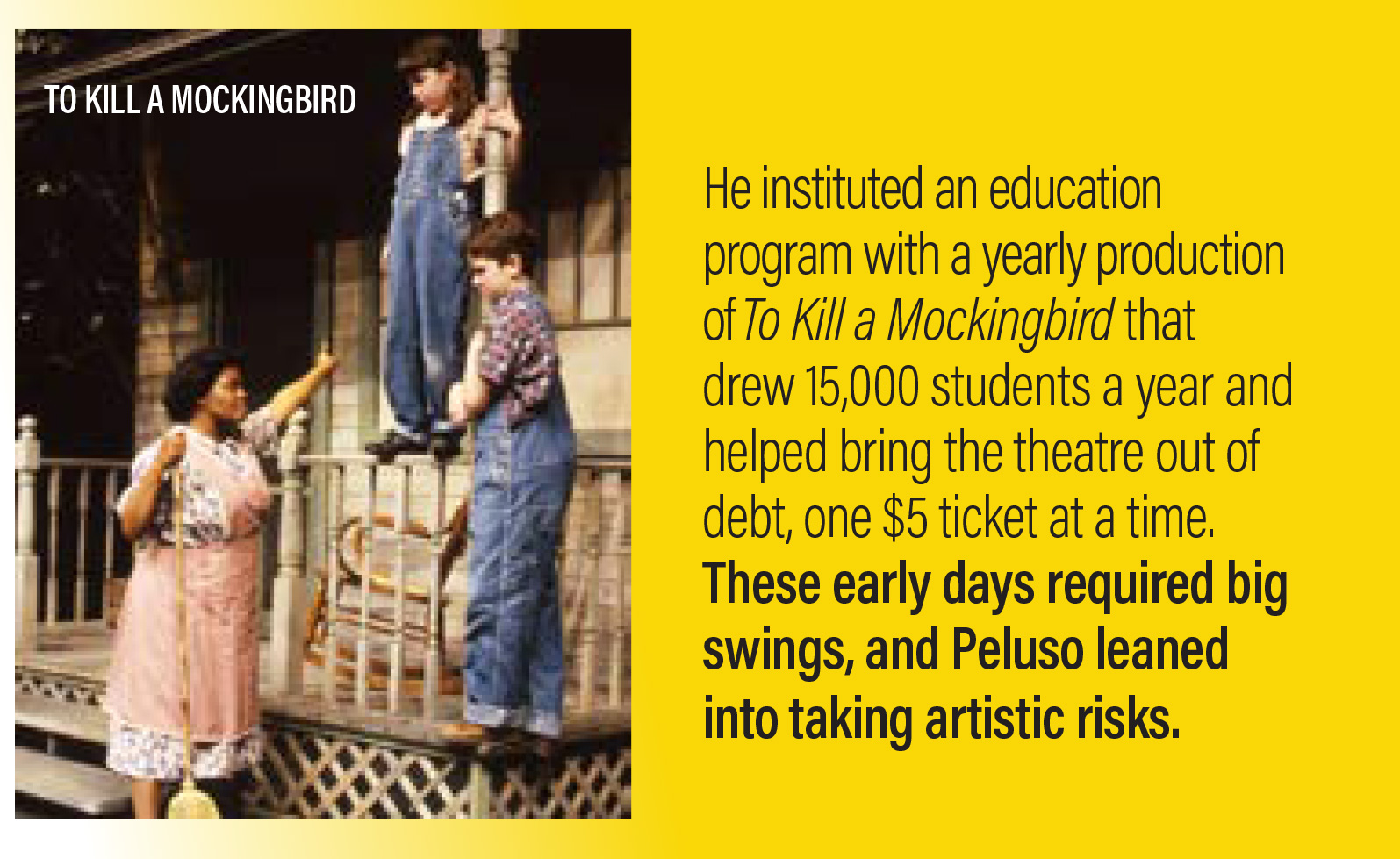Ron Peluso: Telling Real Stories of Real People
The Path to Leadership
Ron Peluso had directed for Chimera Theatre in the Crawford Livingston Theatre in downtown Saint Paul’s Science Museum before the Great American History Theatre moved into the space in 1988. In fact, his production of Candide was one of the final shows in Chimera’s history. Newly appointed as the Artistic Director of Minnesota Festival Theatre, he made a point of seeing actors in shows around town. So when he came to see an actor perform in a History Theatre show that fall, he was in familiar territory. He knew the space intimately, but he had never met History Theatre founders Lynn Lohr and Lance Belville. At intermission, then History Theatre Business Manager Tom Berger asked him to stick around after the show to meet Lynn and Lance. They had lost their director for their upcoming production of A Servants’ Christmas, and they needed a replacement.
By the time the audience had cleared out of the lobby, Peluso had the job, his first official History Theatre show. Shortly after this successful first production, Lohr called Ron one Friday night to see if he would be interested in directing an upcoming production of Mesabi Red. And it was upcoming—fast. Rehearsals started the following Monday, and it didn’t yet have a second act. Bellville’s script was literally half-baked. But this story of the Iron Range strike of 1916 intrigued Peluso, and (as he would do many times over his long career at History Theatre) he put his faith in the collaborative team, which included songwriters Charlie Maguire and Jim Miller. The show went on to be the biggest hit in the theatre’s history and was Ron’s “first miracle.” It would be several years before Ron took over as HT’s Artistic Director, but directing Mesabi Red was a seminal experience for him as he experienced the power of a “History Theatre moment” during the run of that show. As Ron tells it, he was watching a performance from the house when a character in the play—a union striker—was killed off. A buzz of energy and recognition rippled down the row in front of him. Audience members whispered to each other, heads nodding, hands clasped. They had known this man; this was their story. Ron got chills. At that moment, he understood the power of telling real stories about real people, and his artistic vision for the future of History Theatre was born.
Peluso had come to the Twin Cities in 1981 for an MFA in Directing at the University of Minnesota after teaching high school, directing plays, and coaching basketball in Meadville, PA. Like many U of M students and professors at the time, he lived in the Cedar-Riverside Building, and he could see Mixed Blood Theatre from his apartment window. After he finished his MFA he pounded on that firehouse door and a young Jack Rueler gave him a shot as a stage manager, which Ron claims was not his strength. But after stage managing for a couple of years, he pitched a show to Rueler and Jack let him direct Rap Master Ronnie, a satire about Ronald Reagan by Gary Trudeau and Elizabeth Swados. His time at Mixed Blood, the theatre’s mission and Rueler’s ethos left an indelible imprint on Ron; centering a diversity of voices would become one of Ron’s core values when he became Artistic Director at History Theatre.
In 1988 when Peluso met Lohr and Bellville, he had just taken over as Artistic Director of Minnesota Festival Theatre, a summer stock theatre in Albert Lea, MN. For eight years Ron did it all at MFT, right down to mopping the floors, while freelancing and directing opera around the county in the theatre’s off-season. When Lynn and Lance retired from History Theatre in 1995, once again Ron came in to pinch hit as History Theatre’s Interim AD. He was in final interviews for the official position when two comedians known as The D’Unbelievables arrived from Ireland to perform a comedy show. They had been booked by Bellville and their travel had been delayed by visa issues. When they arrived on the day of their first preview, Ron quickly helped them throw up some lights, and they went straight into a preview performance with no rehearsal. But with their thick Irish brogue, no one could understand a word. The audience walked out so fast that Ron wanted to put speed bumps in the aisles. The next morning, Ron brought them into his office to break the news that they had to rework it with him, or he’d have to cancel the run, and they explained why they had been so indecipherable: they had performed the entire show in Gaelic. Belville had led them to believe that the large Irish population in St. Paul would hang on to every (Gaelic) word. Ron righted the ship, rehearsed them on stage, and when the English version opened the next night, it was hailed as “the best new play of the year.” It turned out to be a huge hit and Ron’s next miracle. He got the job.
The Early Years
When Peluso officially took over as Artistic Director in 1995, the theatre had an annual budget of $500,000 and a debt of $400,000. He recalls playing tennis at the Nicollet tennis center when critic Peter Vaughn, playing the next court over, asked him how it felt to be taking over the History Theatre. Ron replied, “It’s like being down a set or two at Wimbledon, it’s Love-40, and you’re down 0-5, but you still have a serve. The game ain’t over yet.” And so, he hit the ball. For his first season, he commissioned Syl Jones to write The Brotherhood, a story about Pullman porters, Beth Gilleland to write Civil Ceremony, a story of women who disguised themselves as men and joined the Union army during the Civil War, and Inner City Opera, a musical by J.D. Steele based on stories collected from young people in the community. He instituted an education program with a yearly production of To Kill a Mockingbird that drew 15,000 students a year and helped bring the theatre out of debt, one $5 ticket at a time. These early days required big swings, and Peluso leaned into taking artistic risks. He recalls the final scene of The Brotherhood (directed by the current Producing/Directing Associate Richard D. Thompson) being handed to the actors on opening night with little time to rehearse. But from the beginning, Ron trusted his writers and artists to deliver the goods, and they did. He invested in local writers and local actors, which he still does to this day, and set his compass toward stories that mattered to the many communities that call Minnesota home. He had always admired how Don Stoltz addressed the audience in a curtain speech every night at the Old Log Theatre, and he made a commitment to do the same. From the stage, he told audiences night after night that this was their theatre, telling their history, and that his door was open if someone wanted to share something they felt should make it to the stage.
Open Doors, Open Hearts
The very next Monday after one such curtain speech in his first season as AD, Ron got a knock on his door. It was three women from The Arc holding boxes of photos and information about life at the Faribault State Hospital, where Minnesotans with intellectual disabilities, mental illness, and young pregnant teens were institutionalized, many of whom died. They brought out photos of children hiding in corners and a picture of a gravestone marked only by the number “415”, asking, “What is the story behind this number and what does it represent?” Playwright Bob Beverage took on the project, and History Theatre collaborated with Jeanne Calvit, Artistic Director of Interact Theater to create Let Heaven and Nature Sing, a story of people who lived in the state hospital, performed by a cast that included both HT and Interact performers. Following the production, Peluso and the late Rick Cardenas, Co-Director of Advocating Change Together, went up the hill to the state capital and successfully lobbied for the “Remembering with Dignity” project, legislation that funded an initiative to locate and provide markers with names for the estimated 13,000 patients who died while living in state institutions and were buried in anonymous, numbered graves. This early experience cemented Ron’s commitment to not only learning from our history but using that new understanding of our shared history to shape the future for Minnesotans beyond the walls of the theatre.
Developing stories, developing a legacy
These core values, which took root in Ron’s early days, grew into a solid foundation that has anchored Ron’s stewardship of History Theatre over his twenty-seven-year tenure as Artistic Director. Drawn to stories of immigration, labor, and social justice, he found no shortage of subjects from influential Minnesotans such as labor and peace activists Mary Pat Laffey (Stewardess by Kira Obolensky, 2019), Nellie Stone Johnson (Nellie by Kim Hines, 2012), and the McDonald sisters (Sisters of Peace by Doris Baizley, 2019), politicians such as Hubert Humphrey (Favorite Son: The Humphrey Perspectives by Jeffrey Hatcher, David Hawley, Kim Hines, and John Olive, 1995) and Paul Wellstone (Wellstone! by Mark Rosenwinkel with music by Larry Long, 2007), artists such as Bobby Vee (Teen Idol: The Bobby Vee Story by Bob Beverage, musical arrangements by George Mauer) and Tyrone Guthrie (Tyrone & Ralph by Jeffrey Hatcher, 2008), and pioneers such as Susan Kimberly (Superman Becomes Lois Lane by Susan Kimberly, 2020). He has commissioned work that captures the unique stories of Minnesotans across a wide spectrum of experiences, such as the first Chinese woman to immigrate to Minnesota (100 Men’s Wife by Jeany Park, 2006), and a young Somali man’s journey to find himself in America (A Crack in the Sky by Harrison David Rivers and Ahmed Ismail Yusuf, 2017), stories of events that changed the course of a community, such as the destruction of Rondo by the construction of I-94 (The Highwaymen by Josh Wilder, 2017) and the raging fire of 1910 that devasted the town of Hinkley (FireBall by Roger Nieboer in collaboration with Joe Chvala and Peter Ostroushko, 2005), and stories that changed the world, like the Betty Pack WWII spy musical (Dirty Business by Laurie Flanigan Hegge with music by Robert Elhai, 2019). And then there’s the monster hit, which Ron directed, based on the infamous murders at Duluth’s Glensheen mansion, Jeff Hatcher and Chan Poling’s musical Glensheen (2015), named the “The Play of the Decade” by the Star Tribune as the calendar turned into 2020. The list of titles in the HT canon of new work goes on and on. (Look at the history of past seasons on HT’s website for a full list.)
While the national theatre community collectively lamented the inequities of the field regarding the number of plays being produced by women and writers of color, Ron continued going about the business of commissioning work from traditionally underrepresented writers, which he had done since the beginning. The amount of new work he has commissioned over his tenure is stunning: 96 new plays and musicals, with 103 commissions to date from emerging to award-winning, nationally known playwrights and composers, with a focus on local writers. As the list of commissions grew, so did the new work development process. In 2003, Ron initiated the Raw Stages Festival, a workshop/reading series of works-in-progress which takes place every January. Authors headed for production receive additional support with a Next Stage workshop. And every year, new projects enter the pipeline, many of which come through that same open door that brought Ron Let Heaven and Nature Sing. Ron’s commitment to work- and artists-in-progress was never so evident as in the rescheduling of work put on hold due to the pandemic. Rather than canceling productions as many theatres have done, Peluso rescheduled them and kept his commitments to all the artists involved whose lives had been upended by the pandemic.
Peluso’s impact on the ecosystem of new work development in the Twin Cities and beyond cannot be underestimated, and yet, in this realm, Ron has largely flown under the radar. He has quietly and steadily nurtured playwrights over whole careers, shepherding their work to the stage while encouraging a search for humanity, heart, and joy inside stories that sometimes ache with discomfort and trouble. His respect for artists is evident in his long-standing relationships with artists across the spectrum who come back to History Theatre to work time and time again. His deft hand as a director is visible on the History Theatre’s stage, which was designed by Ralph Rapson prior to his Guthrie theatre design. And Peluso is an actors’ director, empowering his artists to make bold choices, nurturing young artists, and encouraging collaboration while personally shaping the work on the HT’s intimate thrust.
Over the years, History Theatre has found a new audience and grown exponentially. In the last ten years, Managing Director Karen Mueller has been a great partner to Peluso, securing funding for Next Stage workshops and helping to grow and guarantee the financial stability of the organization, especially through recent COVID shutdowns and the uncertainty brought by the pandemic. Under Ron and Karen’s leadership, even big challenges have presented opportunities for growth. When the now-defunct McNally-Smith College of Music took over the building from the Science Museum, a new, restrictive lease threatened to squeeze the HT, but instead, a collaborative partnership was hatched with the music school, which led to a multi-year, sell-out productions of Buddy: The Buddy Holly Story, which featured students from McNally Smith, financially stabilized the theatre, and brought many new artists into the fold.
Ron is also quick to credit the History Theatre staff and board for helping to ensure the health of the organization and supporting his vision along the way. Board member John Aptiz has served on the board for thirty years; he was on the committee that hired Peluso in 1995 and has been key to the evolution of a strong, diverse Board at HT all this time. Audience Development Director Chari Hall has been at History Theatre longer than Ron has. Their friendship and working relationship have ridden out the ups and downs of openings and closings, big hits and small splashes with an incredible shared history of their own. With a strong vision, board, staff, and financial picture in place, Ron is confident that he will hand his successor the reigns to a stable and robust organization poised for a new chapter of growth.
Looking to the Future
As Lance Belleville tossed the keys to Ron Peluso in 1995, he quipped, “Good luck, I’ve used up all the good stories.” 100-plus new plays later, Ron feels History Theatre has barely scratched the surface, and can’t wait to see what stories his successor commissions. “I’ve had the great joy and honor of deciding what plays get done, whose history gets acknowledged, and whose lives get honored in a very special way,” Peluso says. “It’s been a great privilege. I grew up a Baby Boomer, and my perspective on history was through the eyes of working-class people, Vietnam, the civil rights era…like our founders’ perspective, labor, immigration and social justice were at the heart of it all, and so History Theatre was a great fit for me. Whoever takes over will have a different perspective on history. A new generation will come forward to tell their stories, and I think that’s important.”
And that sums up Ron Peluso. Even as he plans his exit, he’s leaving the door open for the next generation. We will miss you, Ron.






